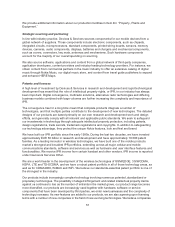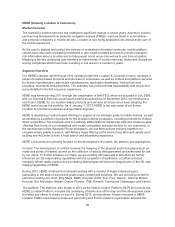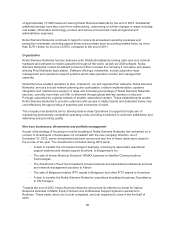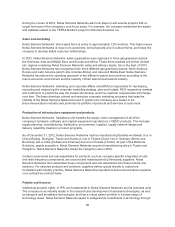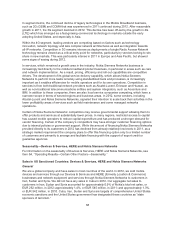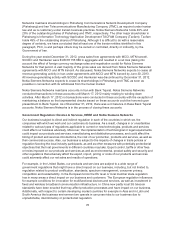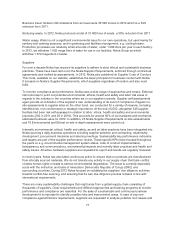Nokia 2012 Annual Report Download - page 68
Download and view the complete annual report
Please find page 68 of the 2012 Nokia annual report below. You can navigate through the pages in the report by either clicking on the pages listed below, or by using the keyword search tool below to find specific information within the annual report.appropriate IPR protections and has generated and maintained an extensive portfolio of patents
covering significant innovations arising from its research and development activities since its formation,
including patents, design patents, trade secrets, trademark registrations and copyrights. Additionally,
where the company deems necessary it obtains licenses to use standards-essential and other patents
in its hardware and software solutions for both fixed and mobile network infrastructure.
Nokia Siemens Networks owns a large portfolio of approximately 3 800 patent families across an array
of technologies, some of which were transferred from Nokia and Siemens upon its formation in 2007.
Nokia Siemens Networks IPR portfolio includes high quality standards essential patents and patent
applications which have been declared to ETSI and other SDOs as essential to LTE, WCDMA,
TD-SCDMA, WIMAX, GSM, CDMA2000 and other standards.
In addition, Nokia Siemens Networks holds copyright registrations relating to certain aspects of its
products and services. The company has in place a number of patent license agreements with other
major companies and patent holders, both directly and through its shareholders, that afford it freedom
to operate without risk of infringing standards-essential patents owned by such entities.
Nokia Siemens Networks receives and pay patent license royalties in the ordinary course of its
business based on existing agreements with telecommunication vendors.
Competition
Conditions in the market for mobile and fixed network infrastructure and related services were
challenging and intensely competitive in 2011 and remained so during 2012. With relatively limited
growth in a negative global economic environment, competition has been intense around growth areas
such as 4G (LTE), which is the current technology battleground in the wireless industry, and in other
network modernization projects.
Industry participants have changed significantly in recent years. Substantial industry consolidation
occurred in 2007 with the emergence of three major European vendors: Alcatel-Lucent, Ericsson and
Nokia Siemens Networks. In January 2011, Motorola Solutions completed its separation from Motorola
Mobility Holdings Inc. In April 2011, Nokia Siemens Networks acquired the majority of Motorola
Solutions wireless network assets.
During this period, the market also saw the rise of Huawei and ZTE, low-cost vendors from China, both
of which have gained market share by leveraging their low-cost advantage in tenders for customer
contracts. In recent years, the technological capabilities of these vendors, particularly Huawei, have
improved significantly, resulting in competition not only on price but also on quality. In 2012, Huawei
and ZTE have continued to grow their market share but at a slower pace than in previous years, further
challenging European vendors. In 2012, Nokia Siemens Networks also witnessed emerging
competition from Samsung Electronics, which has expanded its network infrastructure business out of
its domestic Korean market with limited gains in Europe and the United States.
At present, Nokia Siemens Networks considers five companies – Ericsson, Alcatel Lucent, Huawei,
ZTE and Samsung Electronics – to be its main competitors as major network infrastructure providers.
Nokia Siemens Networks also competes with Cisco Systems, Inc. and NEC Corporation.
In 2012, the telecommunications infrastructure market was characterized by slight growth in capital
expenditures in Euro terms by global mobile operators, mainly attributable to operators in Japan, Asia
Pacific and North America off-set by declines in Europe, China and India.
67


